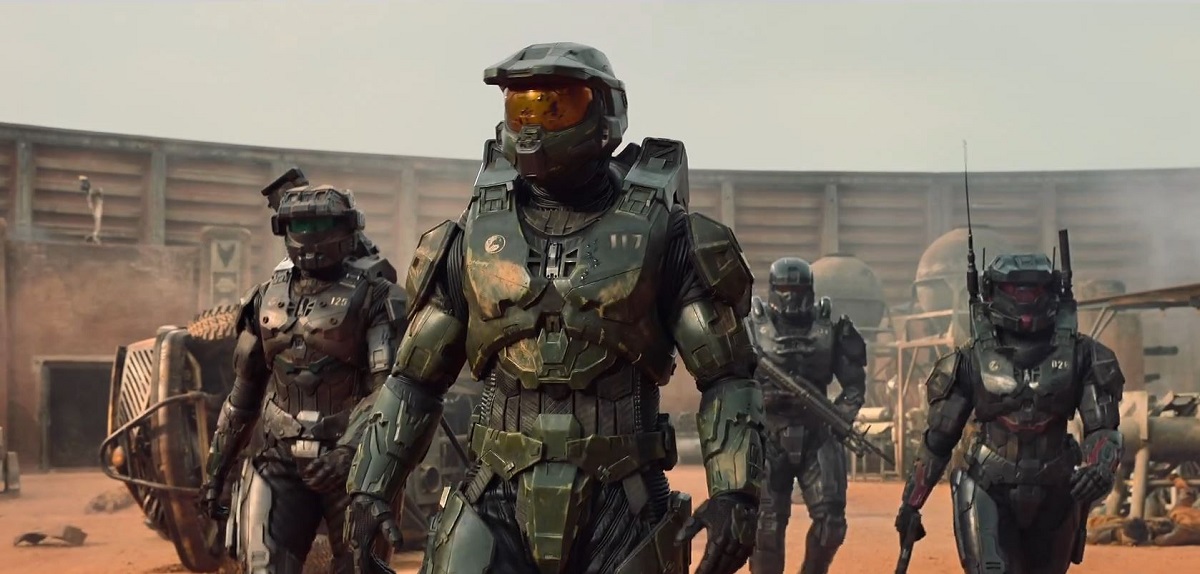You might be wondering why it took Hollywood this long to come up with a Halo adaptation considering the fact that it’s one of the best-selling media franchises of all time. But to answer that question, one must look closer at exactly what it is we’re asking when we bring up the matter of Halo in live-action.
Here is the challenge: A highly popular video game series is to be adapted for the small screens, with a story over twenty years in the telling and a narrative structure exclusively tailored towards the first-person shooter genre. Your main protagonist is an enigmatic killing machine that never takes off his helmet or expresses sentiments significantly. Because why would he need to? He’s a video game character equipped with badass weapons and gadgets, seemingly stuck in a never-ending loop of butchering Covenant troops and all sorts of malignant forces that threaten humanity in the galaxy.
As for the story, well, it basically boils down to a number of missions where Master Chief has to traverse from objective A to objective B, while the rest of the characters take a backseat and coddle humanity’s biggest hope, further expanding the legend of Petty Officer John-117.
Any questions?

When you think about the Halo series in those terms, you begin to understand why the forthcoming Paramount Plus series has been stuck in development hell for so many years, or why numerous creatives have tried, to no avail, to bring the story of Master Chief to life on the small or even the big screens.
Don’t get me wrong; Halo is undoubtedly one of the most influential sci-fi franchises in history, with a nuanced style of storytelling and characterization that elevates it past many other similar games in the industry. But all of those great things work so well because they’ve been implemented as a game. Not a TV show, feature film, or a novel, but a video game series.
Halo is the perfect example of leaving well enough alone because even attempting to adapt it to other mediums is akin to diving headfirst into a creative rabbit hole of crippling proportions. Yet somehow, showrunners Kyle Killen and Steven Kane, with the help of Steven Spielberg, have managed to develop a series that miraculously isn’t a complete disaster.
The fact of the matter is when you start to appreciate the new series for what it’s trying to do, rather than what you think it ought to be doing, the settings and the characters transform into a cohesive body ripe with the potential to hook you in despite all their shortcomings and deviations from the source material. And make no mistakes; there’ll certainly be a slew of them for diehard Halo enthusiasts.
Fans would already be inclined to believe that to an extreme, but it’s frankly not exactly a fair assessment of the adaptation. The producers have had a keen eye for detail, staying true to almost every element of world design in the Halo universe. Whether we’re talking about the guns, the sounds they make, Spartan armors, spaceships, UNSC headquarters, and everything in between, the Halo TV show has done a wonderful job of translating them to live-action medium.

Where the discrepancies do throw you off is when the plot and its characters come into the equation. I think the simple biggest anachronistic moment in the first two episodes features Master Chief himself as he makes his grand entrance in the first ten minutes of the premiere episode.
Much to our dismay, instead of hearing the iconic and ingrained voice of Steve Downes, we hear a rougher and more high-pitched sound. Seeing Master Chief in his iconic armor — crafted with painstaking attention to detail — but hearing a different voice might give many fans a few moments of pause until they register the fact that another actor has picked up the mantle for this series.
American Gods star Pablo Schreiber is the thespian to receive this honor. And while he may not admittedly be our go-to choice for Master Chief, who could anyone possibly pick to portray the legendary character when there isn’t a frame of reference beyond a series of FPS games, much less an actual face? The Canadian-American actor has nevertheless made John-117 his own by adopting almost every mannerism from his video game alter ego, not to mention a deafening stoic calm that goes hand-in-hand with the military prodigy.
The second big hurdle that’ll certainly ruffle a few feathers is when Master Chief takes off his helmet, revealing for the first time in the franchise’s history what the character looks underneath that Spartan armor. This instance is so sensitive in nature that even the show’s producers had to pre-emptively warn everyone that it was going to happen.
It’s true that the creative minds behind Halo have purposefully hidden Master Chief under that helmet for more than 20 years to preserve his apparatus as a symbol of heroism, but unlike a video game that more often than not utilizes gameplay as its scapegoat, movies and TV shows rely too much on narrative and dramatization to simply portray John as an archetypal protagonist.
A lot has been said about how that aspect of the character is similar to The Mandalorian, but unlike Din Djarin, who anchors his story to the expansive Star Wars lore, Master Chief can’t take advantage of a Baby Yoda-esque mystery to keep viewers on the edge of their seats. What he can do, however, is resort to the established rules of drama so that audiences at least give a damn about his character, which, in turn, has obliged the producers to undermine the unspoken creative decree that has held his helmet firmly in place since 2001.

The result is a version of Master Chief that’s off-putting and strange to suffer on the small screens, though one you can definitely get used to, provided that you accept the adaptation for what it is, as opposed to a 1:1 translation. And if Paramount’s plan was to indeed tell a story that viewers gave a damn about — many of whom may have just been introduced to the franchise with this television series — then they’ve managed to stick the landing to a large degree.
Halo arrives in an age where the content frenzy for the numerous streaming platforms currently competing in the market necessitates its existence rather than warrant it. But one thing that separates this from all the other middling genre productions we see on a regular basis is that the industry has been endeavoring to make it a reality even before the end of the golden age of cable TV was nigh on the horizon.
That care, compassion, and obsessive revamping of key elements manage to come through when you sit down to watch the series, even if the final work ultimately isn’t what you’d imagined a Halo adaptation would look like back in the day.
Even the narrative of Halo roughly follows the same premise as in the games, so there’s a case to be made about its potential to reach those storytelling heights through the rest of season one, though in its own style that has been integrated into the television medium.
The first two episodes serve as a promising start for this series, but whether the story will be compelling enough to warrant a multi-season run is a question that only the rest of season one can answer.
Beyond that, Halo is, to a greater extent, a serviceable adaptation that does a well-enough job of setting up the fictional sci-fi universe than it is a revolutionary and game-changing piece of art for the live-action speculative sphere. To that end, go in expecting to be entertained, but not quite exhilarated after the end credits have rolled.
Halo premieres March 24 on Paramount Plus.
Fair
'Halo' accomplishes almost everything that it sets out to do, but even then, it can't soar quite as high as its video game counterpart in terms of narrative and worldbuilding.
Halo

